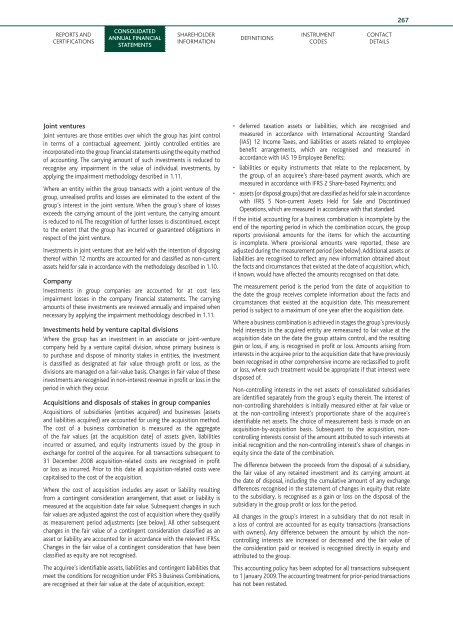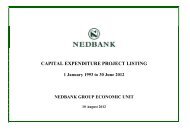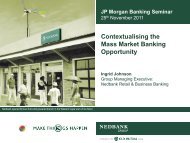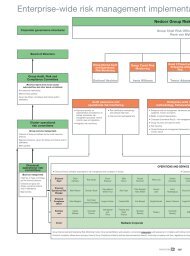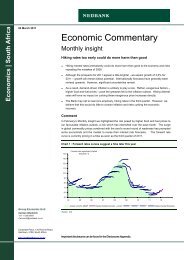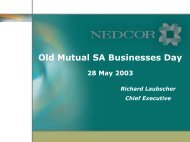Download the PDF (5.4 MB) - Nedbank Group Limited
Download the PDF (5.4 MB) - Nedbank Group Limited
Download the PDF (5.4 MB) - Nedbank Group Limited
You also want an ePaper? Increase the reach of your titles
YUMPU automatically turns print PDFs into web optimized ePapers that Google loves.
267Reports andcertificationsConsolidatedannual financialstatementsShareholderinformationDefinitionsInstrumentcodesContactdetailsJoint venturesJoint ventures are those entities over which <strong>the</strong> group has joint controlin terms of a contractual agreement. Jointly controlled entities areincorporated into <strong>the</strong> group financial statements using <strong>the</strong> equity methodof accounting. The carrying amount of such investments is reduced torecognise any impairment in <strong>the</strong> value of individual investments, byapplying <strong>the</strong> impairment methodology described in 1.11.Where an entity within <strong>the</strong> group transacts with a joint venture of <strong>the</strong>group, unrealised profits and losses are eliminated to <strong>the</strong> extent of <strong>the</strong>group’s interest in <strong>the</strong> joint venture. When <strong>the</strong> group’s share of lossesexceeds <strong>the</strong> carrying amount of <strong>the</strong> joint venture, <strong>the</strong> carrying amountis reduced to nil. The recognition of fur<strong>the</strong>r losses is discontinued, exceptto <strong>the</strong> extent that <strong>the</strong> group has incurred or guaranteed obligations inrespect of <strong>the</strong> joint venture.Investments in joint ventures that are held with <strong>the</strong> intention of disposing<strong>the</strong>reof within 12 months are accounted for and classified as non-currentassets held for sale in accordance with <strong>the</strong> methodology described in 1.10.CompanyInvestments in group companies are accounted for at cost lessimpairment losses in <strong>the</strong> company financial statements. The carryingamounts of <strong>the</strong>se investments are reviewed annually and impaired whennecessary by applying <strong>the</strong> impairment methodology described in 1.11.Investments held by venture capital divisionsWhere <strong>the</strong> group has an investment in an associate or joint-venturecompany held by a venture capital division, whose primary business isto purchase and dispose of minority stakes in entities, <strong>the</strong> investmentis classified as designated at fair value through profit or loss, as <strong>the</strong>divisions are managed on a fair-value basis. Changes in fair value of <strong>the</strong>seinvestments are recognised in non-interest revenue in profit or loss in <strong>the</strong>period in which <strong>the</strong>y occur.Acquisitions and disposals of stakes in group companiesAcquisitions of subsidiaries (entities acquired) and businesses (assetsand liabilities acquired) are accounted for using <strong>the</strong> acquisition method.The cost of a business combination is measured as <strong>the</strong> aggregateof <strong>the</strong> fair values (at <strong>the</strong> acquisition date) of assets given, liabilitiesincurred or assumed, and equity instruments issued by <strong>the</strong> group inexchange for control of <strong>the</strong> acquiree. For all transactions subsequent to31 December 2008 acquisition-related costs are recognised in profitor loss as incurred. Prior to this date all acquisition-related costs werecapitalised to <strong>the</strong> cost of <strong>the</strong> acquisition.Where <strong>the</strong> cost of acquisition includes any asset or liability resultingfrom a contingent consideration arrangement, that asset or liability ismeasured at <strong>the</strong> acquisition date fair value. Subsequent changes in suchfair values are adjusted against <strong>the</strong> cost of acquisition where <strong>the</strong>y qualifyas measurement period adjustments (see below). All o<strong>the</strong>r subsequentchanges in <strong>the</strong> fair value of a contingent consideration classified as anasset or liability are accounted for in accordance with <strong>the</strong> relevant IFRSs.Changes in <strong>the</strong> fair value of a contingent consideration that have beenclassified as equity are not recognised.The acquiree’s identifiable assets, liabilities and contingent liabilities thatmeet <strong>the</strong> conditions for recognition under IFRS 3 Business Combinations,are recognised at <strong>the</strong>ir fair value at <strong>the</strong> date of acquisition, except:• deferred taxation assets or liabilities, which are recognised andmeasured in accordance with International Accounting Standard(IAS) 12 Income Taxes, and liabilities or assets related to employeebenefit arrangements, which are recognised and measured inaccordance with IAS 19 Employee Benefits;• liabilities or equity instruments that relate to <strong>the</strong> replacement, by<strong>the</strong> group, of an acquiree’s share-based payment awards, which aremeasured in accordance with IFRS 2 Share-based Payments; and• assets (or disposal groups) that are classified as held for sale in accordancewith IFRS 5 Non-current Assets Held for Sale and DiscontinuedOperations, which are measured in accordance with that standard.If <strong>the</strong> initial accounting for a business combination is incomplete by <strong>the</strong>end of <strong>the</strong> reporting period in which <strong>the</strong> combination occurs, <strong>the</strong> groupreports provisional amounts for <strong>the</strong> items for which <strong>the</strong> accountingis incomplete. Where provisional amounts were reported, <strong>the</strong>se areadjusted during <strong>the</strong> measurement period (see below). Additional assets orliabilities are recognised to reflect any new information obtained about<strong>the</strong> facts and circumstances that existed at <strong>the</strong> date of acquisition, which,if known, would have affected <strong>the</strong> amounts recognised on that date.The measurement period is <strong>the</strong> period from <strong>the</strong> date of acquisition to<strong>the</strong> date <strong>the</strong> group receives complete information about <strong>the</strong> facts andcircumstances that existed at <strong>the</strong> acquisition date. This measurementperiod is subject to a maximum of one year after <strong>the</strong> acquisition date.Where a business combination is achieved in stages <strong>the</strong> group’s previouslyheld interests in <strong>the</strong> acquired entity are remeasured to fair value at <strong>the</strong>acquisition date on <strong>the</strong> date <strong>the</strong> group attains control, and <strong>the</strong> resultinggain or loss, if any, is recognised in profit or loss. Amounts arising frominterests in <strong>the</strong> acquiree prior to <strong>the</strong> acquisition date that have previouslybeen recognised in o<strong>the</strong>r comprehensive income are reclassified to profitor loss, where such treatment would be appropriate if that interest weredisposed of.Non-controlling interests in <strong>the</strong> net assets of consolidated subsidiariesare identified separately from <strong>the</strong> group’s equity <strong>the</strong>rein. The interest ofnon-controlling shareholders is initially measured ei<strong>the</strong>r at fair value orat <strong>the</strong> non-controlling interest’s proportionate share of <strong>the</strong> acquiree’sidentifiable net assets. The choice of measurement basis is made on anacquisition-by-acquisition basis. Subsequent to <strong>the</strong> acquisition, noncontrollinginterests consist of <strong>the</strong> amount attributed to such interests atinitial recognition and <strong>the</strong> non-controlling interest’s share of changes inequity since <strong>the</strong> date of <strong>the</strong> combination.The difference between <strong>the</strong> proceeds from <strong>the</strong> disposal of a subsidiary,<strong>the</strong> fair value of any retained investment and its carrying amount at<strong>the</strong> date of disposal, including <strong>the</strong> cumulative amount of any exchangedifferences recognised in <strong>the</strong> statement of changes in equity that relateto <strong>the</strong> subsidiary, is recognised as a gain or loss on <strong>the</strong> disposal of <strong>the</strong>subsidiary in <strong>the</strong> group profit or loss for <strong>the</strong> period.All changes in <strong>the</strong> group’s interest in a subsidiary that do not result ina loss of control are accounted for as equity transactions (transactionswith owners). Any difference between <strong>the</strong> amount by which <strong>the</strong> noncontrollinginterests are increased or decreased and <strong>the</strong> fair value of<strong>the</strong> consideration paid or received is recognised directly in equity andattributed to <strong>the</strong> group.This accounting policy has been adopted for all transactions subsequentto 1 January 2009. The accounting treatment for prior-period transactionshas not been restated.


